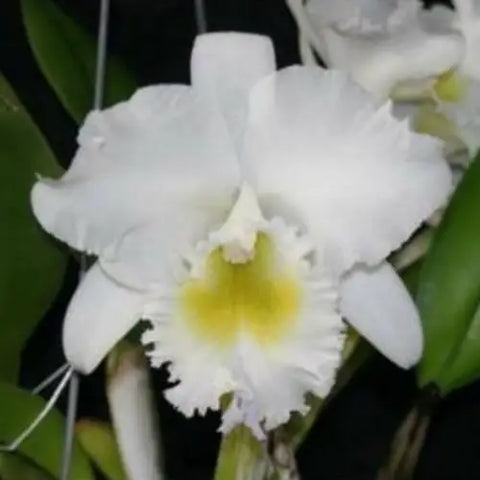
Bl. Morning Glory (B. nodosa x L. purpurata) Cattleya Orchid 3" Pot
Bl. Morning Glory (B. nodosa × L. purpurata) – 3" Pot
Fragrant, Vigorous Cattleya-Type Hybrid with Showy Lip
Bl. Morning Glory is a charming, free-blooming hybrid between Brassavola nodosa and Laelia purpurata, registered in 1958 by Del-Ora. This classic orchid brings together the best traits of both parents: the fragrance and slender growth of B. nodosa combined with the size, form, and showy lip of L. purpurata. The result is a medium to large plant with large, spidery flowers and dramatic lip coloration.
Flowers are typically white or pale blush with bold purple or fuchsia lips—often veined or flared. In some forms, especially those influenced by C. purpurata var. sanguinea, the lip color may appear even darker. These blooms are highly fragrant, especially in the evening, making this a sensory favorite in any collection.
This offering is for a near blooming size plant in a 3" pot. With proper care, plants often reach blooming maturity within 6–12 months.
Why Growers Love Bl. Morning Glory
Growers love Bl. Morning Glory for its ease of care, sweet fragrance, and striking floral display. It’s a vigorous grower that adapts well to various growing environments—making it suitable for windowsills, baskets, mounts, or pots. The blooms are unique: slender petals with a wide, vibrant lip that makes each flower stand out. The evening fragrance inherited from B. nodosa fills the space with a light, citrusy sweetness. This orchid is also known for blooming more than once a year, especially under bright light and good airflow.
Whether you’re a beginner looking for a reliable bloomer or an experienced collector seeking a classic hybrid, Bl. Morning Glory delivers color, fragrance, and charm.
Botanical Profile
-
Hybrid Name: Brassolaelia (Bl.) Morning Glory
-
Parentage: Brassavola nodosa × Laelia purpurata
-
Registered By: Del-Ora (1958)
-
Pot Size: 3"
-
Growth Stage: Near Blooming Size
-
Bloom Size & Form: Spidery flowers, often large with full lips
-
Color: White or blush with purple or fuchsia lips (veining/flaring possible)
-
Fragrance: Yes – evening, sweet citrus scent
-
Bloom Season: Fall and spring; may bloom year-round in good conditions
-
Growth Habit: Medium to large plant; slender nodosa form with taller purpurata influence
-
Foliage: Terete leaves; suitable for pots, baskets, or mounts
Cattleya Culture
Light:
Light is the most important factor for growing and blooming cattleyas. They love bright light—but not harsh, direct sun in the middle of the day. In your home, an east-facing window is ideal, or a shaded south or west window (use a sheer curtain if needed). In a greenhouse, aim for 50–70% full sun (about 3,000 to 5,000 foot-candles). A healthy Cattleya should have medium green leaves and stand upright without needing a stake.
Temperature:
Cattleyas like it warm during the day—about 70–85°F—and cooler at night—around 55–60°F. Seedlings do best with slightly warmer nights. A day/night difference of 15–20 degrees helps trigger blooming. They can handle up to 95°F if humidity and airflow are increased.
Watering & Humidity:
Watering depends on your pot size, media, temperature, and light levels. Mature plants need to dry out completely before the next watering. Seedlings prefer a bit more moisture. You can tell when it’s time to water by lifting the pot—light means dry, heavy means wet. When in doubt, wait a day. Never use water below 50°F, and avoid softened water with added salts.
Cattleyas enjoy humidity between 50–80%. At home, use a humidity tray with pebbles and make sure your pot doesn’t sit in the water. Airflow is key—moving air helps prevent disease. In greenhouses, use humidifiers or evaporative coolers to maintain proper moisture in the air.
Fertilizing:
Feed your cattleyas regularly. If you're growing in fir bark, use a high-nitrogen formula like 30-10-10. Otherwise, use a balanced fertilizer. During active growth, fertilize every two weeks. When growth slows, switch to once a month. You can also feed lightly (at ¼ strength) every time you water. Once a month, flush with plain water to wash out any salt buildup.
Repotting:
Repot every 2–3 years or when you see roots creeping over the edge or the potting mix breaks down. The best time to repot is right after blooming or in spring—just before new roots start to grow. Use coarser mix for mature plants, finer mix for young ones. Only divide a plant if it has at least 6 pseudobulbs. Each division should have 3–5 healthy bulbs. Pick a pot that allows for two years of new growth.
To repot:
-
Place fresh mix against one side of the new pot.
-
Trim any dead roots.
-
Lay the healthy roots on the mix with the cut rhizome against the pot wall.
-
Fill in and firm the mix around the roots.
-
Stake if needed.
-
Keep humid and shaded until you see new root growth.
We Also Recommend





